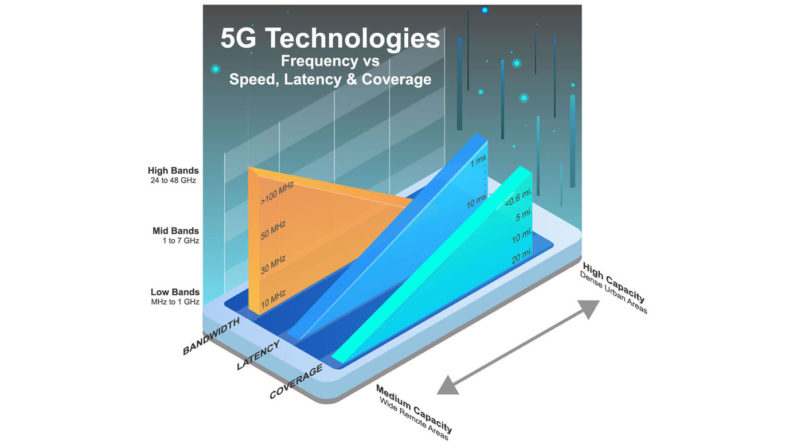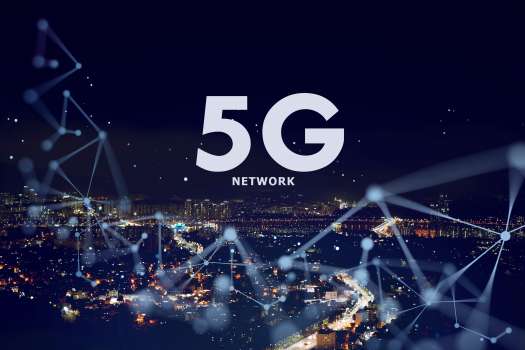5G tasks in IoT

This is part one of a three-part series that will address 5G and LPWAN and their impact on industrial IoT.
- Part one addresses the question, “what is 5G” with respect to the IIoT?
- Part two will do some myth-busting of 5G and LPWAN
- Part three will provide a 5G and LPWAN vision of what new capabilities, architectures and applications these technologies will enable.
In 2019, 5G technology climbed to the peak of the curve on the Gartner Hype Cycle for emerging technologies. That means we’re right at the peak of curiosity, excitement and confusion about what the technology is, how it will be used and when it will be ready. In this article, we’ll help address the confusion about 5G and low power wide area networks (LPWANs).
In the world of the Industrial IoT, 5G and its notable LPWAN competitor LoRaWAN will be key players in the enablement and acceleration of IoT deployments.
Let’s start with 5G. 5G represents the fifth generation of cellular technology. If you’ve been a bit confused about the messaging around 5G and what it can do, it’s likely because 5G represents a range of different capabilities targeting multiple use cases which will become available at different points along the lifecycle of 5G.
Keeping things simple, let’s segment 5G into three buckets:
- 5G for more speed
- 5G for ultra-low latency
- 5G and LPWAN for low-power and slow-speed connected devices
5G for Speed
Let’s start with the easiest to grasp 5G use case, speed. 5G offers 10 to 100 times throughput capability over fourth generation LTE. According to Fierce Wireless, who tirelessly measures the performance of U.S. carriers, today’s 4G LTE networks in the U.S. have actual average throughputs hovering in the 25 Mbps range. With 5G, theoretical rates start around 1 Gbps, with the ability to hit 10 Gbps using band aggregation. Field results in early deployment markets have already published results from hundreds of Mbps to 1.2 Gbps.
If we only think about 5G’s impact on the cellular handheld market, this isn’t all that exciting. More speed is nice when you’re downloading five seasons of “Silicon Valley.” But, the slowest part of your handheld is the human interface – the ability for your eyes and ears to consume data, or your fingers or voice to produce data. That use case hardly requires gigabit speeds. But, if instead we consider things like 5G fiber replacement, providing gigabit plus connections to businesses, homes, surveillance systems, remote sites, traffic intersections, all with zero wiring cost, you can envision both how new applications will be enabled, as well as how existing technologies will be disrupted.
5G for Ultra-low Latency
Latency represents the lag between initiating a data request and receiving a response. The current state of LTE latency in the U.S. ranges between 40 and 60 milliseconds. This is plenty fast enough for the human-device interface for the applications we use today. But 5G holds the promise of driving latency down as low as 1 millisecond. That level of latency opens the door to many real-time use cases. The gaming community will love it. New applications will spring up where real-time human-to-human connections are needed. Want to record a real-time jam session between musicians in New York, L.A. and Chicago? They’ll now be able to perform together “live” online just as if they were all standing together on a single stage.
But the real magic will be in machine and motion control applications where things move faster than humans, precision is required and a lot can happen in 50 milliseconds. Swarms of drones will be able to communicate together in real time. High speed motion control in automation and manufacturing will no longer be tethered by costly-to-install data cables. Eliminating the latency between our physical and digital worlds will enable new augmented reality applications where we will be able to overlay digital information with our own sensory experience in real time.
There is a caveat with this particular 5G benefit. You will only experience this ultra-low latency benefit if you’re 5G is being served up in the high frequency “millimeter wavelength” bands of the 5G spectrum. These are 24GHz and higher frequencies. The challenge with this is that, as frequency goes up, range and ability to penetrate obstructions goes down. So, if you’re planning to build a high tech 5G factory, you’ll need to work with your carrier to install a set of 5G millimeter-wave antennas throughout your facility. If you are in a dense population city, major carriers will likely invest in millimeter wavelength cell site deployments. If you’re in a low density or rural location, you’re not likely to experience that low latency benefit.
There is much written about how 5G will enable autonomous vehicles. This may be true, but my opinion is, it may be overstated. Low latency is certainly critical to high speed motion control. If you know your latency and you know your speed, you can easily calculate the buffer zone, or margin of error, required to ensure a positive result. But more important than latency is another concept called “determinism.” If latency may be 1 ms, or it may be 5 or 10 ms, it is difficult to take advantage of anything more than the worst case latency of the system. The best applications for the ultra-low latency benefits of 5G will be in fixed site applications where a millimeter wave network infrastructure can be guaranteed.
5G and LPWAN for Low Power, Slow Speed Connected Devices
If you’ve heard of LTE Category M1 and Narrow Band IoT (NB-IoT), they too are part of the 5G family. Ironically, Cat M1 and NB-IoT aren’t about speed at all. Just the opposite, they are about slowing down communications in order to increase range and decrease power consumption. This set of 5G technologies enables us to integrate wireless communications into small, ultra-low power devices. These devices can be battery powered, or even powered by energy harvesting techniques. Sensors on roadways, in bridges and fields all add to the ability for us to connect our physical and digital worlds.
5G Category M1 and NB-IoT aren’t the only technologies aimed at connecting low power sensors. A competing technology called LoRaWAN uses an unlicensed spectrum to target the same application. LoRaWAN uses unlicensed, low frequency bands (915 MHz in North America) and advanced wireless technology to achieve excellent range and low power communications for very low speed devices. LoRaWAN, 5G Category M1 and NB-IoT will compete for many of the same low power wireless sensing applications.
5G and LPWAN will be enabling technologies of further IIoT growth and continuously growing use cases. Some of its benefits will come sooner than others. Category M1, NB-IoT and LoRaWAN are market-ready today. Some features will roll out in different markets at different rates. And still others will take years to realize. Now is a great time to start to envision and evaluate how and when these technologies will impact your products, services and operations.

